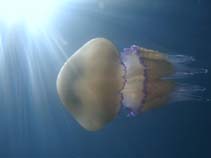Rhizostoma pulmo (Macri, 1778)
Barrel jellyfish
Classification / Names Common names | Synonyms | CoL | ITIS | WoRMS
Scyphozoa | Rhizostomeae | Rhizostomatidae
Environment: milieu / climate zone / depth range / distribution range Ecology
Pelagic; depth range 0 - 40 m (Ref. 122800). Subtropical; 46°N - 30°N, 5°W - 42°E (Ref. 121705)
Distribution Countries | FAO areas | Ecosystems | Occurrences | Introductions
Mediterranean and Black Sea: from Alboran Sea to Libya in the Mediterranean, east to Russia and north to Ukraine, Black Sea.
Length at first maturity / Size / Weight / Age
Maturity: Lm ?, range 12 - 15 cm Max length : 90.0 cm WD male/unsexed; (Ref. 358); common length : 60.0 cm WD male/unsexed; (Ref. 358)
Short description Morphology
Life cycle and mating behavior Maturity | Reproduction | Spawning | Eggs | Fecundity | Larvae
Main reference
References | Coordinator | Collaborators
Göthel, H. 1992 Guide de la faune sous-marine: La Méditerranée. Invertébrés marins et poissons. Eygen Ulmer GmbH & Co. 318 p. (Ref. 358)
IUCN Red List Status
(Ref. 130435: Version 2025-1)
CITES status (Ref. 108899)
CMS (Ref. 116361)
Threat to humans
Human uses
Fisheries: commercial
| FishSource |
Tools
More information
Max. ages / sizes
Length-weight rel.
Length-length rel.
Length-frequencies
Mass conversion
Abundance
Internet sources
BHL | BOLD Systems | CISTI | DiscoverLife | FAO(Publication : search) | Fishipedia | GenBank (genome, nucleotide) | GloBI | Gomexsi | Google Books | Google Scholar | Google | PubMed | Tree of Life | Wikipedia (Go, Search) | Zoological Record



